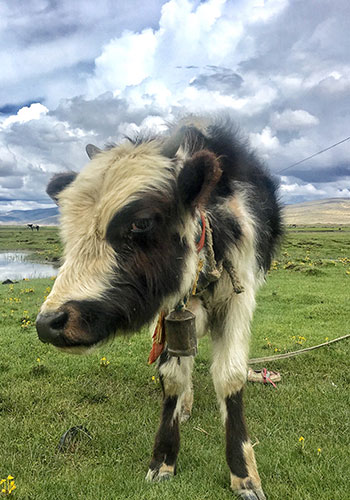
A yak on the plateau (Photo: Li Jingjing/GT)
Rules for survival
The high altitude basically requires that we change the lifestyle that we were used to.
1. Being 'slow' is key.
Better to make every movement as slow as possible. Walk, and walk slowly, instead of running, jogging or jumping.
Try not to do exercise or any sports. Any fast movement puts an extra burden on your heart and lungs which are already overwhelmed trying to bring oxygen to your whole body.
Many people faint from doing sports in Tibet because they didn't feel any altitude sickness.
I didn't feel any sickness until the day I headed to Namtso, a mountain lake in central Tibet which is about 4,700 meters above sea level. No matter how slowly I walked, I could feel my heart was racing like I had just finished a 100-meter race.
So I chose to sit down all the time and rest more often, even though that meant missing out on a few scenic spots. It turned out that this was good choice, because after that day, I didn't suffer from high altitude sickness symptoms even when I went to Mount Qomolangma Base Camp, which is 5,200 meters above sea level.
2. Take less showers
This is a common rule accepted by travelers in Tibet. Don't take showers or wash your hair during your first two days in Tibet, and don't take showers that frequent either afterward, because that also contributes to high altitude sickness and may lead you to catching a cold as well.
3. About oxygen bottles
Many people are so worried about altitude sickness that they carry oxygen bottles and take hits off of it whenever they feel any symptoms. That is the wrong move.
Do not use oxygen bottles unless you absolutely have to. They are more for those suffering severe symptoms, like someone who has fainted.
It's natural to feel symptoms like headache, loss of appetite or a racing heartbeat, but the human body is very adaptive.
Give yours enough time to actively adapt to this low oxygen environment and you will be able to enjoy your visit without any symptoms.
However, using oxygen bottles when small symptoms occur affects the body's ability to adapt. Then these symptoms may follow you during the entire trip.
Getting there
There are many routes and transportation in different cities in China, including direct flight and oxygen-pumped trains.
However, foreigners need to participate in group tours organized by travel agencies.
It may sound dull. But Tibet is a very large place which means it takes dozens of hours to drive from place A to B.
The complicated geography of Tibet also means not every driver can handle traveling by themselves.
In that case, taking an organized tour with an experienced driver and huge oxygen bottle on board will actually make your trip safer.
Things to remember
Tibet is a very religious region and local people have many customs and traditions. It's important to respect their culture.
It's very common to see people praying, either in the cities or out in the wilds. It's okay to give them a little bit of money. Yet I saw too many tourists taking photos of them, which kind of disturbed them.
When visiting temples, please wear long sleeves and long pants to cover yourselves. Female visitors shouldn't come into physical contact with monks.
Many parts of Tibet are still less developed, especially in remote mountain areas. On Mount Qomolangma Camp Base, even water is a luxury.
Local villagers have to walk a very long way to get water from wells and have to carry it back themselves.
So hygiene conditions will be quite different from what we are used to in cities - it's normal for places not to have running water or modern toilets.
Many people call Tibet the last pure land, as the wilderness, people and culture seem less impacted by the modern world.
Everything you see and experience there is quite different from our daily lives.
Although it might be tough at time, the experience is definitely worth the trouble.


















































